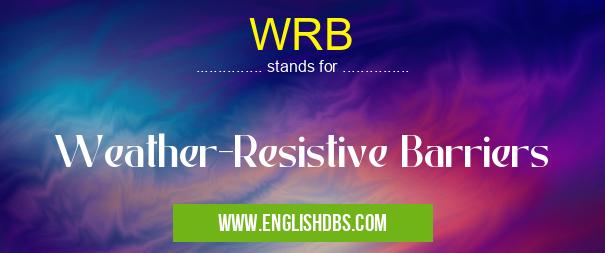What does WRB mean in ARCHITECTURE
Weather-Resistive Barriers (WRBs) are essential components of exterior wall systems in modern construction. They play a crucial role in protecting buildings from moisture penetration, air leakage, and other environmental factors. Understanding the meaning and significance of WRBs is vital for architects, builders, and homeowners alike.

WRB meaning in Architecture in Academic & Science
WRB mostly used in an acronym Architecture in Category Academic & Science that means Weather-Resistive Barriers
Shorthand: WRB,
Full Form: Weather-Resistive Barriers
For more information of "Weather-Resistive Barriers", see the section below.
What does WRB Stand for?
The acronym WRB stands for Weather-Resistive Barriers. These barriers are designed to:
- Resist the penetration of water and moisture from the exterior
- Prevent air infiltration and exfiltration
- Provide a weathertight seal around windows, doors, and other openings
- Protect the interior of the building from moisture damage, mold growth, and other structural issues
Types of WRBs
WRBs can be categorized into two main types:
- Housewrap: A thin, flexible sheet material that is applied to the exterior of the wall sheathing. It provides a primary barrier against moisture and air.
- Building Paper: A heavier, more durable material that is typically installed under the siding or other exterior finish. It offers additional protection against moisture and can also serve as a vapor barrier.
Materials used in WRBs
WRBs are typically made from various materials, including:
- Polyethylene
- Tyvek
- Tar paper
- Asphalt-saturated felt
Essential Questions and Answers on Weather-Resistive Barriers in "SCIENCE»ARCHITECTURE"
What are Weather-Resistive Barriers (WRBs)?
WRBs are building materials designed to protect buildings from the elements, including rain, wind, and snow. They are typically installed on the exterior of a building, over the sheathing and under the siding or roofing materials. WRBs help to keep water out of the building while allowing water vapor to escape, preventing mold growth and structural damage.
What are the different types of WRBs?
There are three main types of WRBs:
- Housewrap: A lightweight, flexible material that is applied directly to the sheathing. It is typically made of a synthetic material, such as polypropylene or polyethylene.
- Felt paper: A thick, paper-like material that is installed over the sheathing and under the roofing materials. It is typically made of asphalt-impregnated cellulose fibers.
- Self-adhered membranes: A type of WRB that has a self-adhesive backing. It is applied directly to the sheathing and does not require any nails or staples.
What are the benefits of using WRBs?
WRBs offer a number of benefits, including:
- Protection from the elements: WRBs help to keep water, wind, and snow out of the building, protecting the interior from damage.
- Prevention of mold growth: WRBs allow water vapor to escape from the building, preventing the accumulation of moisture that can lead to mold growth.
- Increased energy efficiency: WRBs can help to reduce energy costs by preventing air leaks, which can lead to heat loss in the winter and heat gain in the summer.
Final Words: Weather-Resistive Barriers are indispensable elements of exterior wall systems. They ensure the durability and integrity of buildings by protecting against moisture intrusion, air leakage, and other environmental hazards. Choosing the appropriate WRB for a specific application is essential to optimize building performance and longevity. By understanding the meaning and significance of WRBs, construction professionals and homeowners can make informed decisions that contribute to the overall quality and efficiency of their buildings.
